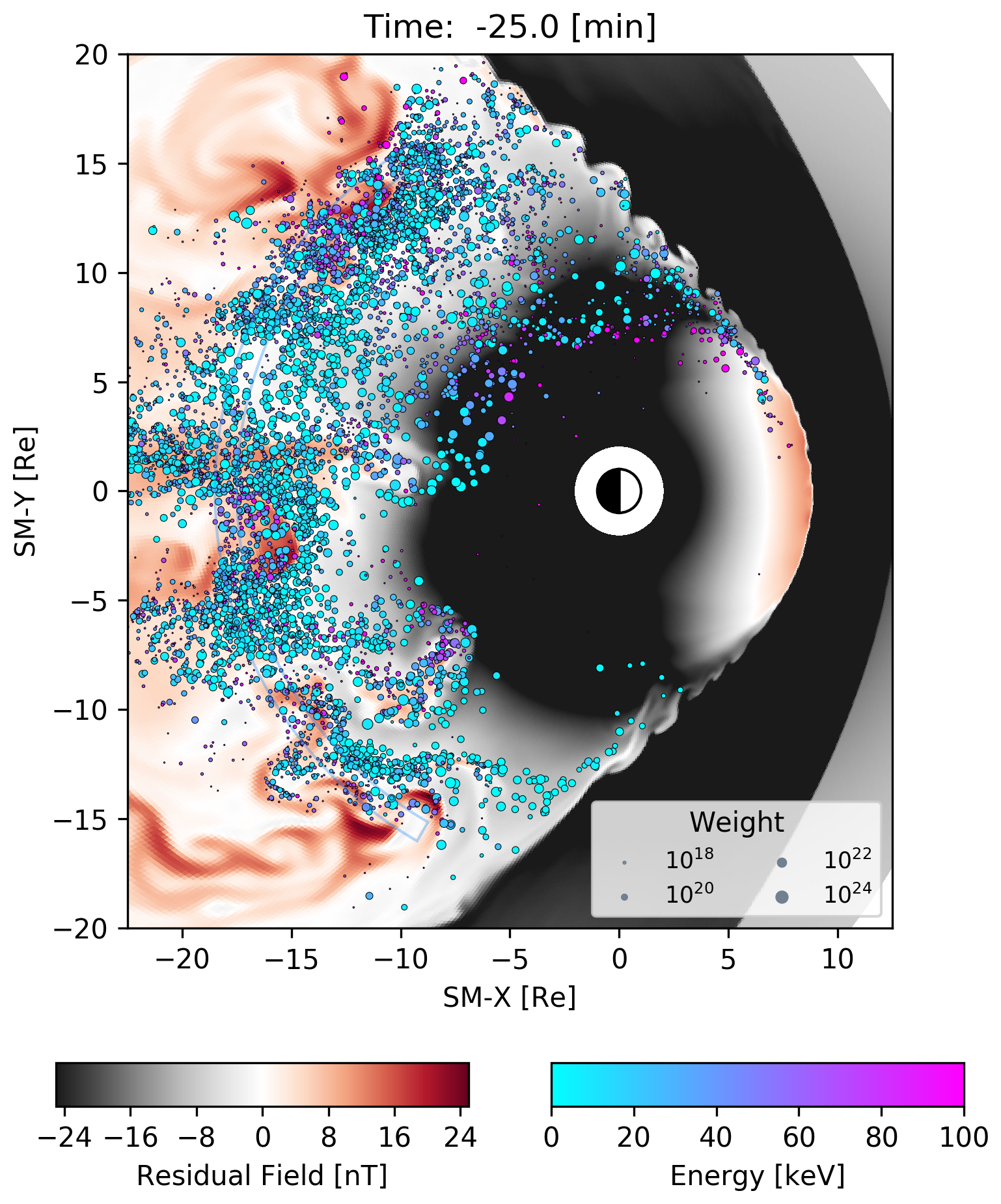CHIMP
Conservative Hamiltonian Integrator for Magnetospheric Particles
CHIMP (Conservative Hamiltonian Integrator for Magnetospheric Particles, Sorathia et al., 2017, 2018, 2019) is a massively parallel test particle code designed to calculate particle trajectories through electromagnetic fields provided by GAMERA (or any other source of electromagnetic fields). CHIMP uses the same software and algorithmic infrastructure as GAMERA which optimizes performance and, similar to GAMERA, geometric flexibility. CHIMP provides three major functions: electromagnetic field interpolation on curvilinear, non-orthogonal grids; calculation of charged particle trajectories with algorithms tailored to cold solar wind ions to relativistic radiation belt electrons; and finally the calculation of phase space density using a weighting procedure directly informed by the varying density and temperature of the MHD bulk flow. Electromagnetic field interpolation is necessary for evolving charged particles but also provides an important tool to bolster MHD simulations. CHIMP massive parallel capability and treatment of complex grid geometries allows it to quickly and accurately couple the GAMERA global magnetosphere to the RCM inner magnetosphere models using the magnetic field topology. These tools also provide powerful diagnostics to study phenomena revealed in the massive datasets generated by our highest resolution magnetosphere models, which produce 1TB/model-hour. An example of this is the fast computation of flux-tube entropy to study the role of buoyancy in transport to the inner magnetosphere.

CHIMP simulation of transport and acceleration of ions into the inner magnetosphere due to bursty bulk flows in the magnetotail.
Particle trajectories are calculated using either the full Lorentz equations of motion or a Hamiltonian guiding center formulation based on the ratio of gyroradius to the local magnetic field curvature. CHIMP complements the high resolving power of GAMERA by providing a means to explore the interaction of high-energy charged particles with mesoscale flow structures and how those interactions play an important role in global geospace dynamics. Examples include transport and acceleration of ions and electrons due to bursty bulk flows from the magnetotail, providing ring current ions and radiation belt electrons to the inner magnetosphere (Ukhorskiy et al., 2018, Sorathia et al., 2018), and the role of Kelvin-Helmholtz vortices in regulating the flow of mass into and out of the magnetosphere (Sorathia et al., 2017, 2019).The final component of CHIMP is the assignment of weights to test particles to calculate phase space density. The weights effectively transform test particles into macroparticles, the weight representing how many real particles each test particle is a proxy for. This has allowed us to use CHIMP and GAMERA in tandem to create an outer radiation belt model capable of capturing the stormtime dynamics of the outer belt on unprecedented timescales (Sorathia et al., 2018), a capability with important space weather applications.
CHIMP already plays an important role in the first incarnation of the MAGE model, connecting the 3D global magnetosphere domain (GAMERA) to the 2D spatial domain of the inner magnetospheric model using fast magnetic field-line tracing on the native non-orthogonal, curvilinear GAMERA domain. This is utilized for mapping both ion and electron fluxes, the latter being used for evaluating atmospheric precipitation. Going forward, CHIMP will play a more important role by bridging the physics of the magnetotail transition region, the nightside domain between the stretched magnetotail and largely dipolar inner magnetosphere. This transition region is characterized by the confluence of fast flows due to burst bulk flows and energy-dependent drift physics which challenges basic assumptions of both the global MHD and inner magnetosphere models. The kinetic particle capabilities of CHIMP will provide a mechanism to track the non-thermal plasma population as it traverses the magnetotail transition region in the MHD domain and provide phase space density (PSD) boundary conditions to the inner magnetosphere model, thus significantly improving upon the current approach which uses a Maxwellian PSD with the MHD plasma moments. The first step towards a broader and comprehensive treatment of the transition region will be to use CHIMP test particles to connect O+ outflow driven by the polar wind model, IPWM, to the outer boundary of the inner magnetosphere model, RCM, which will allow us to incorporate important zero-order non-adiabatic effects known to be important for O+ ions.
References
Sorathia, K., Merkin, V., Ukhorskiy, A., Mauk, B., Sibeck, D. (2017). Energetic particle loss through the magnetopause: A combined global MHD and test-particle study Journal of Geophysical Research: Space Physics 122(9), 9329 - 9343. https://dx.doi.org/10.1002/2017ja024268
Sorathia, K., Ukhorskiy, A., Merkin, V., Fennell, J., Claudepierre, S. (2018). Modeling the Depletion and Recovery of the Outer Radiation Belt During a Geomagnetic Storm: Combined MHD and Test Particle Simulations Journal of Geophysical Research: Space Physics 123(7), 5590-5609. https://dx.doi.org/10.1029/2018ja025506
Sorathia, K., Merkin, V., Ukhorskiy, A., Allen, R., Nykyri, K., Wing, S. (2019). Solar Wind Ion Entry Into the Magnetosphere During Northward IMF. Journal of geophysical research. Space physics 124(7), 5461-5481. https://dx.doi.org/10.1029/2019ja026728
Ukhorskiy, A., Sorathia, K., Merkin, V., Sitnov, M., Mitchell, D., Gkioulidou, M. (2018). Ion Trapping and Acceleration at Dipolarization Fronts: High-Resolution MHD and Test-Particle Simulations Journal of Geophysical Research: Space Physics 123(7), 5580-5589. https://dx.doi.org/10.1029/2018ja025370